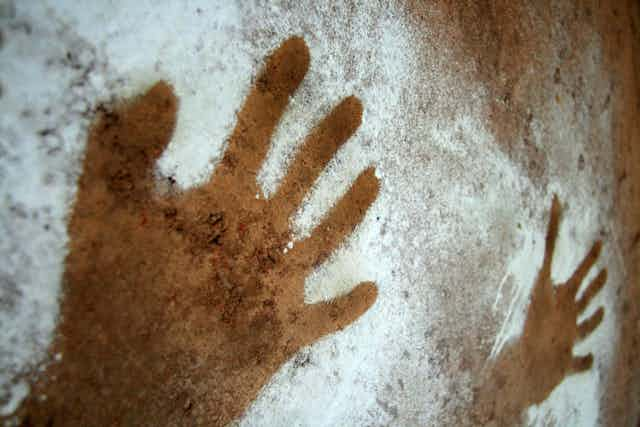My Australian-educated friends tell me they were taught at school that all Aboriginal people only counted one, two, three, four and many. While it might be the case for some communities, there is also abundant evidence in others of complex Aboriginal number systems extending to high numbers.
The Australian writer Dame Mary Gilmore, for example, commented in her 1934 book Old Days Old Ways: A Book of Recollections that:
The Aboriginal power to count or compute in his native state was as great as our own […] I have seen partially trained native stockmen give the exact number of cattle in a group up to four or five hundred almost without a moment’s hesitation, yet authorities on the blacks continue to tell us that the Aboriginal only counted to ten or thereabouts.
Wardaman senior elder Bill Yidumduma Harney, co-author of 2003’s Dark Sparklers: Yidumduma’s Wardaman Aboriginal Astronomy Northern Australia, explains how cattle are counted:
We go five and five all the way and then bunch it up. Go five and five is ten. Then count the number of tens. We call that Yigaga.
I have listed elsewhere many other examples of traditional Aboriginal people counting to high numbers.
Origin of a myth
So why do some people believe the generalised view that all Aboriginal people can’t count beyond four when there is abundant evidence to the contrary?
I suspect part of this myth has its roots in a distant colonial past when the British invaders maintained a belief, on which the “terra nullius” concept was based, that Aboriginal people were barely human, without culture, civilisation or counting.
When my wife and I were in the Tiwi islands in 2005, the local children were competing to see who could hold their breath longest under water. Although my guidebook said they couldn’t count beyond four in their Tiwi language, they were clearly counting to 50 or 60 in a non-English language.

But the myth is reinforced by a linguistic debate about Aboriginal counting words. For example, the distinguished Australian linguist Barry Blake famously said in his 1981 book, Australian Aboriginal Languages: A General Introduction that:
No Australian Aboriginal language has a word for a number higher than four.
Blake’s statement refers to a linguistic nuance that does not include compound words such as “thirteen” or “twenty-one”, so Blake would probably also say that, with the exception of the words “hundred”, “thousand” and “million”, the English language does not have a word for a number higher than twelve.
But even Blake’s statement has counter-examples. In 1881, James Dawson, in his work The Languages and Customs of Several Tribes of Aborigines in the Western District of Victoria, reported that the Kuurn kopan noot (Gurnditjmara) language has a word for 20 (peep) and 100 (Baarbaanuung).
The Chaap wuurong (Djabwurrung) people had a number system extending to 28 – the number of days in a lunar month – each of which was identified as a place on the body, and as a verbal name which also described that part of the body.
These examples are obviously inconsistent with Blake’s statement, as he recently acknowledged to me:
Fair enough. These would be exceptions to my generalisation.
The myth continues
But the real problem is that his original generalisation is often misinterpreted to mean all Aboriginal people can’t count beyond four or Aboriginal people don’t have a concept of numbers greater than four, both of which are obviously incorrect.
Even worse, respectable academic papers continue to be published that fly in the face of the evidence.
Last year researchers Kevin Zhou and Claire Bowern, from Yale University, argued in a paper that Aboriginal number systems vary, and could extend beyond ten, but still didn’t extend past 20, in conflict with the evidence I’ve mentioned above.
As a physicist, I am fascinated by the fact that the authors of this paper didn’t engage with the contrary evidence. They simply didn’t mention it. Why?
Although my training is in astrophysics, I have for the last few years studied Aboriginal Astronomy, on the boundary between the physical sciences and the humanities, and I am beginning to understand a major difference in approach between the sciences and the humanities.
What the data say
In physics, data rule supreme. The most brilliant theory by the most eminent physicist in the world can still be shot down by the lowliest graduate student if it is found to be in conflict with the data.
Of course, data may occasionally be disputed, but that process is explicit, calling for a re-examination of the data, or for the experiment in question to be repeated. A physics paper promoting a theory while simply ignoring conflicting data would not survive the peer-review process, or the subsequent derision.
In humanities, the data is often much more dependent on the skills and interpretation of the researcher.
Ethnographic information suffers from potential errors of misunderstanding, mistranslation and misinterpretation, so is fundamentally less reliable than taking a physical measurement with laboratory equipment or a telescope.
Ethnographic experiments are not repeatable. Once a subject has been exposed to the ethnographer, their answers are unlikely to vary. In physics terms, the ethnographer has collapsed the probability wave function.
So perhaps it isn’t surprising that papers written by scientists differ in their conclusion from those written by anthropologists and linguists. But which is right?
As a scientist, I will argue that the true answer is the one most firmly based on evidence. Presumably my linguist and anthropologist friends will disagree. And my post-modernist friends will question the notion of truth, and say we all have a valid narrative.
Sorry, but speaking as a scientist, if I can find a single reliable piece of evidence that is inconsistent with your theory, then your theory is Wrong. You might disagree. But please don’t ignore it.

